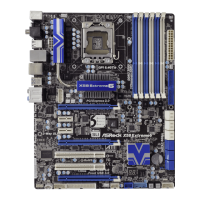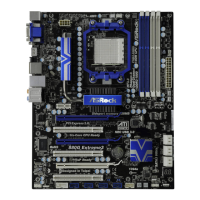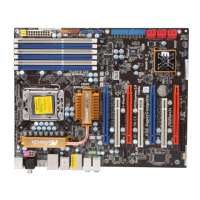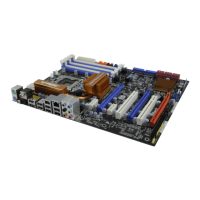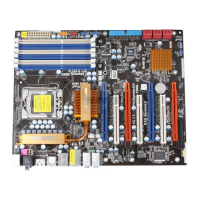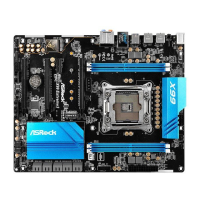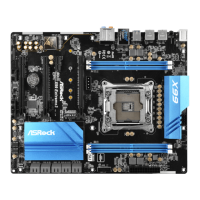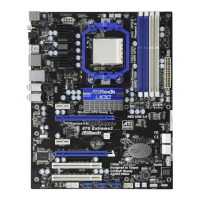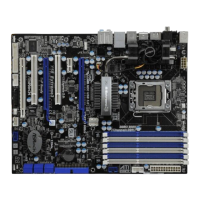
Do you have a question about the ASROCK X58 EXTREME3 - V1.0 and is the answer not in the manual?
| Chipset | Intel X58 |
|---|---|
| CPU Socket | LGA 1366 |
| Maximum Memory | 24GB |
| SATA 3Gb/s | 6 x SATA 3Gb/s |
| RAID Support | RAID 0, 1, 5, 10 |
| USB Ports | 12 x USB 2.0 |
| Form Factor | ATX |
| eSATA | 1 x eSATA 3Gb/s |
| CPU Type | Core i7 |
| Memory Slots | 6 x DDR3 |
| Memory Standard | DDR3 1600/1333/1066 |
| Expansion Slots | 3 x PCI Express 2.0 x16, 2 x PCI |
| SATA 6Gb/s | 2 x SATA 6Gb/s |
| Onboard Audio | Realtek ALC892 |
| Onboard LAN | Realtek RTL8111DL |
| PS/2 Ports | 1 |
Lists the items included in the motherboard package.
Details the technical specifications of the motherboard.
Lists NVIDIA SLI compatible graphics cards.
Lists ATI CrossFireX compatible graphics cards.
Identifies and labels all connectors and components on the motherboard.
Describes the rear input/output ports and their functions.
Instructions for securing the motherboard to the chassis using screws.
Essential safety and handling precautions before installing components.
Step-by-step guide for installing the CPU into the socket.
Guide for mounting the CPU cooler and connecting its fan.
Instructions for installing RAM modules into the DIMM slots.
Details on installing expansion cards into PCI and PCIe slots.
Guide for setting up NVIDIA SLI and Quad SLI configurations.
Guide for setting up ATI CrossFireX and Quad CrossFireX configurations.
Information on enabling surround display with add-on graphics cards.
Explains the function and configuration of motherboard jumpers.
Identifies and describes various onboard headers and connectors.
Details the function of power, reset, and clear CMOS switches.
Explains Dr. Debug codes for troubleshooting boot issues.
Guide for connecting the HDMI_SPDIF header for audio output.
Instructions for installing SATA/SATAII hard drives.
Instructions for installing SATA3 hard drives.
Explains hot-plug and hot-swap capabilities for SATA/SATAII HDDs.
Explains hot-plug and hot-swap capabilities for SATA3 HDDs.
Detailed guide on performing hot plug/unplug for SATA/SATAII/SATA3 HDDs.
General instructions for installing system drivers from the support CD.
Guide for installing OS with RAID functions.
Specific guide for XP OS with RAID functions.
Steps to set up a system for future RAID migration.
Procedures to migrate a RAID Ready system to RAID 0, 1, or 5.
Specific guide for Win 7/Vista OS with RAID functions.
Guide for installing OS without RAID functions.
Specific guide for XP OS without RAID functions.
Specific guide for Win 7/Vista OS without RAID functions.
Explanation of the untied overclocking technology feature.
Overview of the BIOS Setup Utility and how to enter it.
Describes the main menu bar options available in the BIOS.
Explains the function of keys used for navigating the BIOS setup utility.
Description of the Main screen displaying system overview and navigation keys.
Details on adjusting overclocking settings and CPU/DRAM frequencies.
General overview of advanced configuration options.
Settings for advanced CPU features like Hyper-Threading and Virtualization.
Settings related to the motherboard chipset features like audio, LAN, and power saving.
Settings for power management and ACPI features like Suspend to RAM.
Configuration for SATA/SATAII/SATA3 devices, including RAID modes.
Settings for PCI devices and BusMaster.
Configuration options for the floppy drive.
Settings for serial and infrared ports.
Settings for USB controller, USB 2.0, Legacy USB, and USB 3.0 support.
Monitoring system hardware status like temperatures, fan speeds, and voltages.
Configuration of boot devices and boot priority.
Settings for Full Screen Logo, AddOn ROM Display, and Boot Up Num-Lock.
Setting and changing system passwords for security.
Options for saving, discarding, or loading BIOS settings.
General guidance on installing supported operating systems.
Details on the contents of the support CD and how to use it.
Instructions on launching the support CD's main menu or setup utility.
Information on installing device drivers from the support CD.
Information on installing utility software from the support CD.
How to get contact information for ASRock support.

